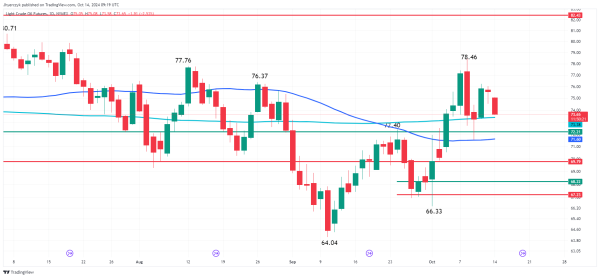Oil News: Crude Futures Fall as China Deflation Fears Spark Bearish Sentiment
Crude Oil Futures Drop as China Demand Concerns Weigh on Prices
Light crude oil futures started the week sharply lower, hovering just above the 200-day moving average of $73.38 per barrel. Traders are closely watching this level, as failure to hold it could lead to further declines towards the 50-day moving average of $71.60. However, a rebound could drive prices back toward last week’s high of $78.46, presenting a critical juncture for market sentiment.

At 09:33 GMT, Light Crude Oil futures are trading $73.91, down $1.65 or -2.18%.
Oil Prices Slide Amid China Demand Fears
Crude oil prices have erased nearly all the gains from last week as concerns over China’s weakening economic data and uncertain stimulus plans dominate market sentiment. Both Brent and West Texas Intermediate (WTI) futures fell by more than 1.5% earlier on Monday. Brent gained 99 cents last week, while WTI increased by $1.18, but those gains were wiped out after Chinese inflation data showed continued deflationary pressures.
China’s September economic data underscored these concerns, with deflationary signals suggesting weaker domestic consumption. Despite promises of stimulus, the lack of clarity from Chinese officials on the scale of any potential measures has further dampened market confidence. This uncertainty is particularly concerning given China’s status as the world’s largest crude oil importer.
Impact of China’s Stimulus Uncertainty on Crude Oil Prices
China has pledged additional fiscal stimulus to support its faltering economy, promising to “significantly increase” debt issuance. However, the absence of concrete figures for the stimulus package has left markets in suspense. Investors are seeking more details to assess the long-term impact on commodity markets, including crude oil. While China’s Finance Minister Lan Foan outlined measures to tackle local government debt, support low-income households, and bolster the property sector, the specifics remain vague.
The lack of immediate, large-scale fiscal measures disappointed many traders. Vasu Menon, investment strategy head at OCBC, noted that the market was hoping for a more aggressive “big bang” approach to stimulate the economy and drive commodity demand, which has yet to materialize. This has led to increased volatility in oil markets, with prices fluctuating on speculation about Chinese demand recovery.
Geopolitical Tensions Provide Limited Support
Meanwhile, geopolitical risks continue to linger, as concerns over potential disruptions to oil production from an Israeli response to Iran’s recent missile attack remain on traders’ radars. Although the U.S. has cautioned Israel against targeting Iranian energy infrastructure, any escalation could still impact supply, offering some temporary support to prices. However, for now, the weight of Chinese economic uncertainty overshadows these geopolitical risks.
Market Forecast: Bearish Near-Term Outlook
Given the ongoing concerns over China’s deflationary pressures and the lack of clarity on stimulus measures, the short-term outlook for crude oil remains bearish. While buyers may attempt to defend the crucial support level at $73.38, a failure to hold this could see prices fall to $71.60 or lower. Until there is more certainty about China’s economic recovery and stimulus scale, traders should brace for continued downward pressure on oil prices.